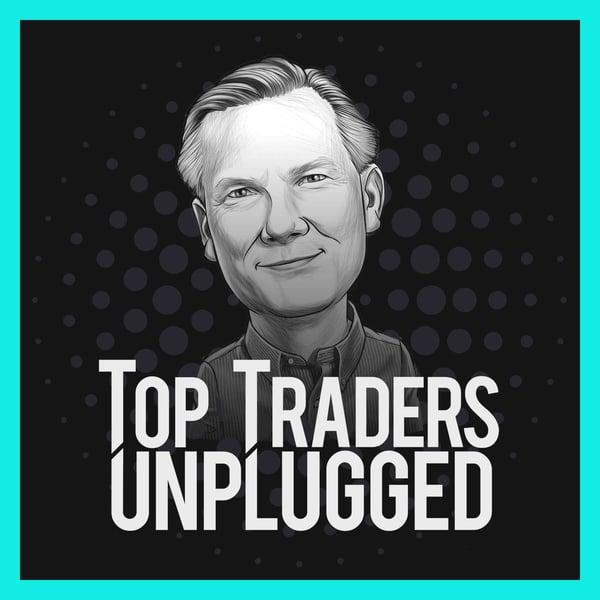TTU36: A Look inside a Currency Trading Firm ft. Chris Cruden of Insch Capital Management – 2of2
Top Traders Unplugged
Niels Kaastrup-Larsen
4.8 • 670 Ratings
🗓️ 2 October 2014
⏱️ 66 minutes
🧾️ Download transcript
Summary
In Part 2 of our conversation with the CEO of Insch Capital Management, we talk about how the firm’s trading models work and how they were built. We discuss how Insch deals with drawdowns, increased regulation, and marketing. This is a truly in-depth episode into the mind of a hedge fund Founder and the inner workings of an Alternative investment firm.
Welcome to the second part of our conversation with Chris Cruden.
-----
50 YEARS OF TREND FOLLOWING BOOK AND BEHIND-THE-SCENES VIDEO FOR ACCREDITED INVESTORS - CLICK HERE
In This Episode, You’ll Learn:
- Indicators that are more robust than others.
- Chris’ views on stop losses.
- How his firm deals with risk and how he uses Index Risk.
- How correlations play a part in his models.
- About risk equivalency.
- how he deals with drawdowns.
- Why a sense of humor is important in this business, especially during drawdowns.
- How investors don’t share the same confidence in the model as managers and how managers can better share that confidence.
- How simple his system really is.
- Why you must have discipline. Many trend followers are making all-time highs but many people have announced the death of trend following time and time again.
- What the “black swan” event and the “gray swan” event would be for Chris’ business.
- The two kinds of research that his firm does.
- Why his team looks at emerging currencies in their research even though they do not trade them.
- What he is looking for in terms of red flags during his research that suggest models need to be tweaked.
- How he tries to stand out from the crowd in order to attract investors.
- Why he is based in Lugano, Switzerland.
- What Chris would ask David Harding if he was doing the interviewing instead of being interviewed.
- What investors forget to ask him.
- Why it’s a good idea to ask if you can try a dummy account with a new investment manager to see how it works.
- How he deals with the difficulties of regulation.
-----
Resources & Links Mentioned in this Episode:
- Market Wizards: Interviews with Top Traders
- Trend Following: How to Make Millions in Up or Down Markets
Follow Niels on Twitter, LinkedIn, YouTube or via the TTU website.
IT’s TRUE ? – most CIO’s read 50+ books each year – get your FREE copy of the Ultimate Guide to the Best Investment Books ever written here.
And you can get a free copy of my latest book “Ten Reasons to Add Trend Following to Your Portfolio”
Transcript
Click on a timestamp to play from that location
| 0:00.0 | You're listening to Top Traders Unplugged, episode number 036, where I continue my conversation with Chris Cruden, founder and CEO of Inch Capital Management. |
| 0:13.1 | This episode is sponsored by Swiss Financial Services. |
| 0:17.7 | Welcome back to Top Traders Unplugged, where the best traders in the world come to share their experiences, their successes, and their failures. |
| 0:25.7 | Let's rejoin the conversation with your host, veteran hedge fund manager, Niels Kastrup Larson. |
| 0:34.4 | You know, a good man. I mean, you've looked at obviously many different indicators over time, I'm sure, and I'm just curious in general. |
| 0:51.4 | I mean, again, if we were going to help sort of the listeners and maybe |
| 0:56.9 | the people who are who are aspiring to become, you know, a manager of funds at some point |
| 1:05.1 | in their career, are there any indicators that you feel are more robust than others? |
| 1:13.8 | The only input we take for our system is price. |
| 1:18.5 | So we really don't look at indicators per se, other than the ones I previously mentioned, volatility and whatever measure you're using for momentum or breakout or that sort of thing. |
| 1:34.9 | Indicators, I wouldn't even describe anything we do as being an indicator per se. |
| 1:39.6 | It either is or it isn't. |
| 1:40.9 | Right. |
| 1:41.8 | And when you get your signal, do you go all in in one go or do you scale in or scale out? |
| 1:48.0 | No. |
| 1:49.0 | First of all, if it's an existing account, an account that's already up and running, in other |
| 1:54.0 | words, fully invested at the prescribed leverage, we will describe them in terms of units of risk. So our system can be flat. In other words, it can have no position. |
| 2:06.6 | Currently, we have four flat positions. It can be long one risk unit, long two risk units, or short one risk risk unit or short two risk units. |
| 2:18.8 | Yeah. |
| 2:19.3 | And that's it. |
| 2:20.8 | And in terms of the, I guess that's a little bit into sort of the risk management side. |
| 2:27.4 | Can you maybe visualize a little bit about how much or maybe I should even say how little |
... |
Please login to see the full transcript.
Disclaimer: The podcast and artwork embedded on this page are from Niels Kaastrup-Larsen, and are the property of its owner and not affiliated with or endorsed by Tapesearch.
Generated transcripts are the property of Niels Kaastrup-Larsen and are distributed freely under the Fair Use doctrine. Transcripts generated by Tapesearch are not guaranteed to be accurate.
Copyright © Tapesearch 2025.

